Quick summary:
We’re going to chat about what is market demand and how to calculate it. Ever wondered why people buy stuff and how to know what they want? We’re going to spill the beans! We’ll talk about what people like, what they’re willing to pay, and all that good stuff. Stick around for numerous examples, and factors that could help your business soar!
What is market demand?
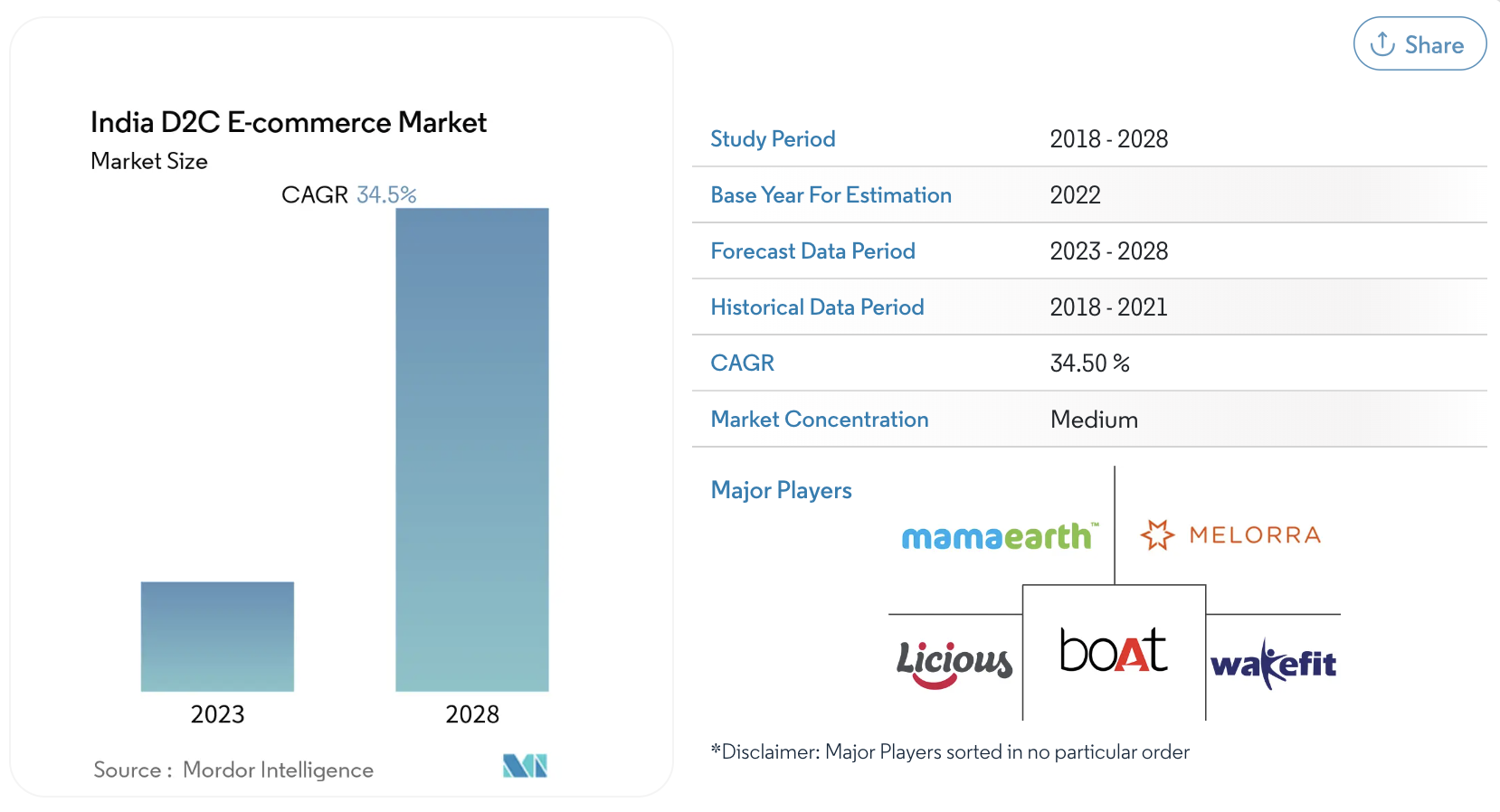
Before looking at the definition of the market demand, let’s understand the economic definition. GDP, or Gross Domestic Product, is like the scorecard for a country’s economy. It tells us the total value of everything a country produces in a year, and it’s a way to see how well an economy is doing.
Likewise, the market demand is all about how many people want to buy a certain product at different prices. It’s like figuring out how popular something is among all the shoppers.
But here’s the thing: it’s not just about one person’s wish list. But, the market demand looks at what a whole bunch of people want. The more people want it, the higher the market demand would be. Yes, this is the same concept we all have gone through during our 11th standard economics.
Think of it this way: when everyone’s buzzing about a new iPhone15 and lining up to buy it, that’s high market demand. On the flip side, if only a handful of people are into vintage cars, that’s low market demand.
In a nutshell, it’s all about the product people want and how much they’ll pay for it.
Here are some examples of how market demand impacts revenue.
As per IBEF:
- India’s dishwasher industry will top $90 million by 2025-26, thanks to rising demand in major cities like Mumbai, Hyderabad, Delhi, and Bangalore.
- India’s ACE market will double to US$ 17.93 billion by 2025, ranking fifth globally.
- In 2021, the industry was worth US$ 9.84 billion, set to exceed US$ 21.18 billion by 2025.
Market demand example
Alright, now that we’ve got a grip on what market demand is, let’s make it even clearer with a simple example of Bombay Shaving Company. This is how they presented themself in front of the people in the market.

1. Understanding market demand
Bombay Shaving Company started its journey by recognising an unmet need in the market. Many Indian men were looking for high-quality grooming products but often had to settle for subpar options: the company noted.
The market demand was clear – men wanted grooming products that were not just functional but also provided a superior experience.
2. Product innovation
To cater to this demand, the brand focused on innovation. They developed a range of grooming products, including razors, shaving creams, and skincare items, designed specifically to meet the preferences and needs of Indian men.
This attention to detail in product development ensured that they could effectively address market demand.
3. eCommerce strategy
Bombay Shaving Company embraced the D2C model, which allowed them to connect directly with their consumers. This approach not only helped them understand market demand better but also enabled them to respond quickly to changing preferences and trends.
Through their eCommerce platform, they collected customer feedback and used it to refine their products continually.
4. Customer-centric approach
Bombay Shaving Company excels in this area by actively engaging with their customers, taking their suggestions into account, and tailoring their product offerings accordingly.
They’ve created a loyal customer base by offering products that resonate with their target audience.
5. Brand building
Bombay Shaving Company focused on creating a strong brand presence. Their branding and marketing strategies align with the aspirations and values of their target market or audience, which has helped build trust and further create more demand.
Their products are not just grooming tools; they are part of a lifestyle brand that speaks to the modern Indian man. By understanding the current demand, they managed to create a brand that fuels this demand and enhances it.
Types of market demand
Did you know the market demand isn’t a one size fits all concept? Well, it’s as diverse as the products and the services which people desire. Let’s have a look at the different market demand types for better understanding.
1. Primary demand
- Definition: This is the demand for a general product category or type. For instance, people have a primary demand for smartphones, without specifying a particular brand or model.
- Example: When someone says, “I need a new smartphone,” they’re expressing primary demand.
2. Derived demand
- Definition: Derived demand arises from the demand for another product or service. It’s often seen in B2B (business-to-business) scenarios, where the demand for one product depends on the demand for another.
- Example: If the demand for laptops increases, there’s a derived demand for laptop bags.
3. Competitive demand
- Definition: Competitive demand arises when consumers have to choose between similar products from different brands or suppliers.
- Example: If you’re in the market for a new laptop and you’re considering both Dell and HP, you’re dealing with competitive demand.
4. Direct demand
- Definition: This is the demand for a product that’s used directly by consumers for their personal needs or consumption.
- Example: When you buy a smartphone for your own use, it’s a direct demand.
5. Indirect demand
- Definition: Indirect demand relates to products that are not used directly but are necessary for the production or consumption of other goods or services.
- Example: The demand for smartphone components, like microchips, is indirect because it’s driven by the demand for smartphones.
6. Seasonal demand
- Definition: Some products experience fluctuations in demand based on seasons, holidays, or specific times of the year.
- Example: Swimsuits have a higher demand in the summer months.
Also, to make you understand the 8 components of market demand, we’ve created an infographic. Let’s have a look:
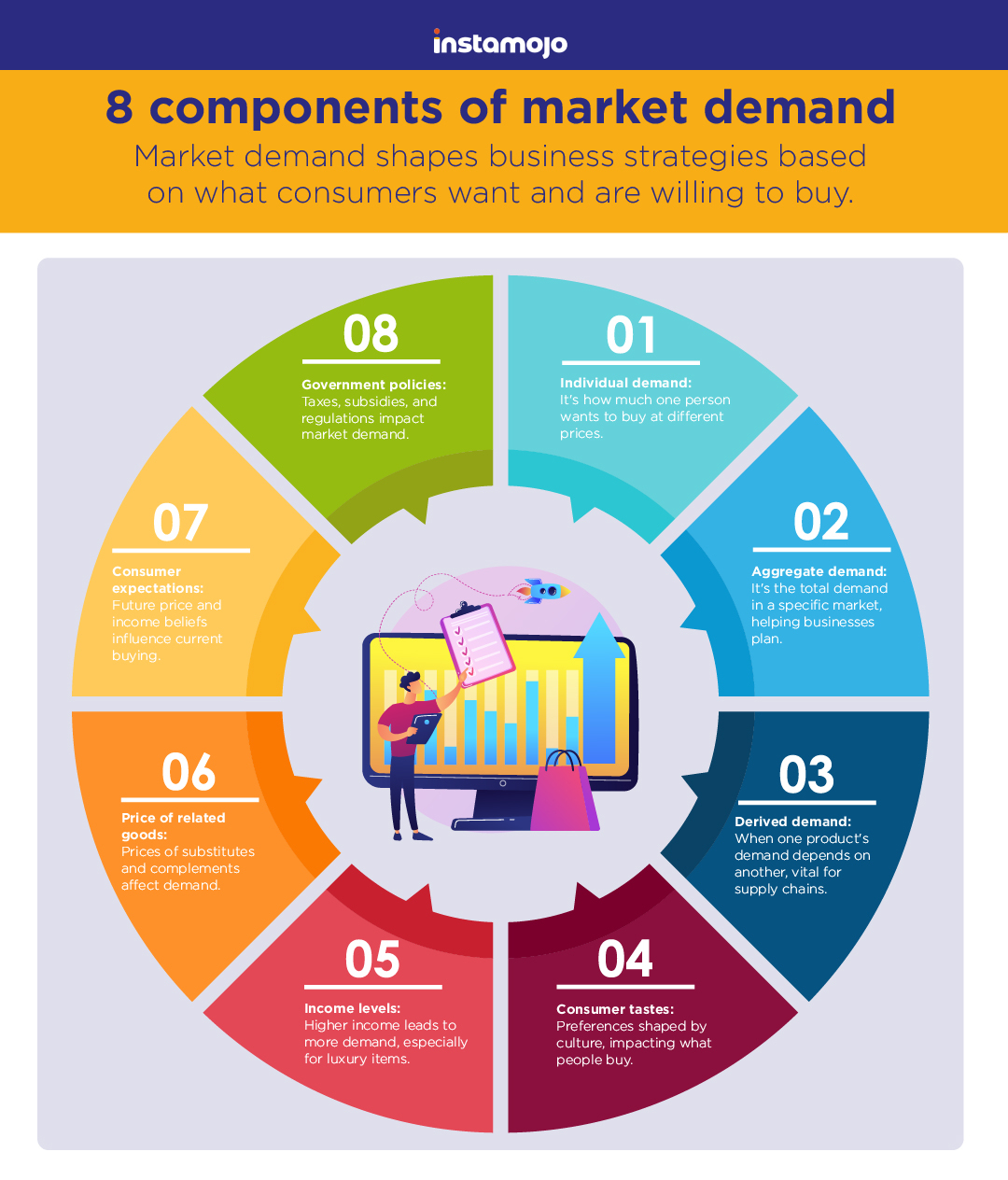
Individual demand and market demand
To understand the individual demand and market demand, let’s have a look at the table that provides a clear overview of the distinctions between the both, highlighting their respective definitions, scopes, determinants, and applications.
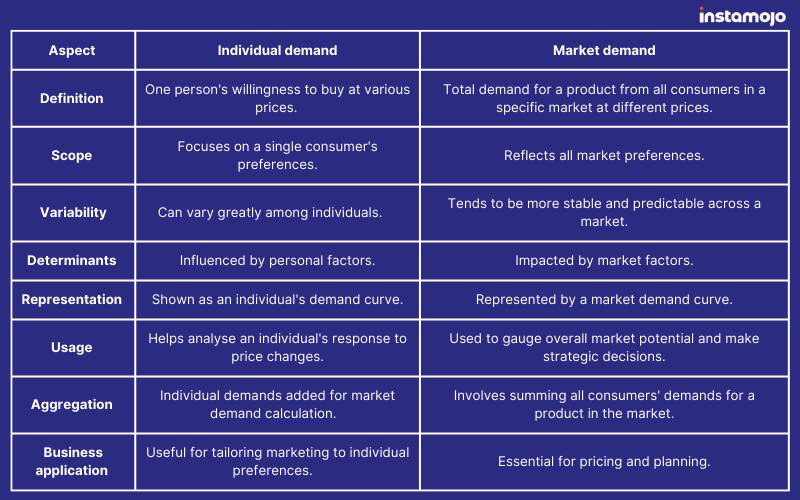
What’s a market demand curve?
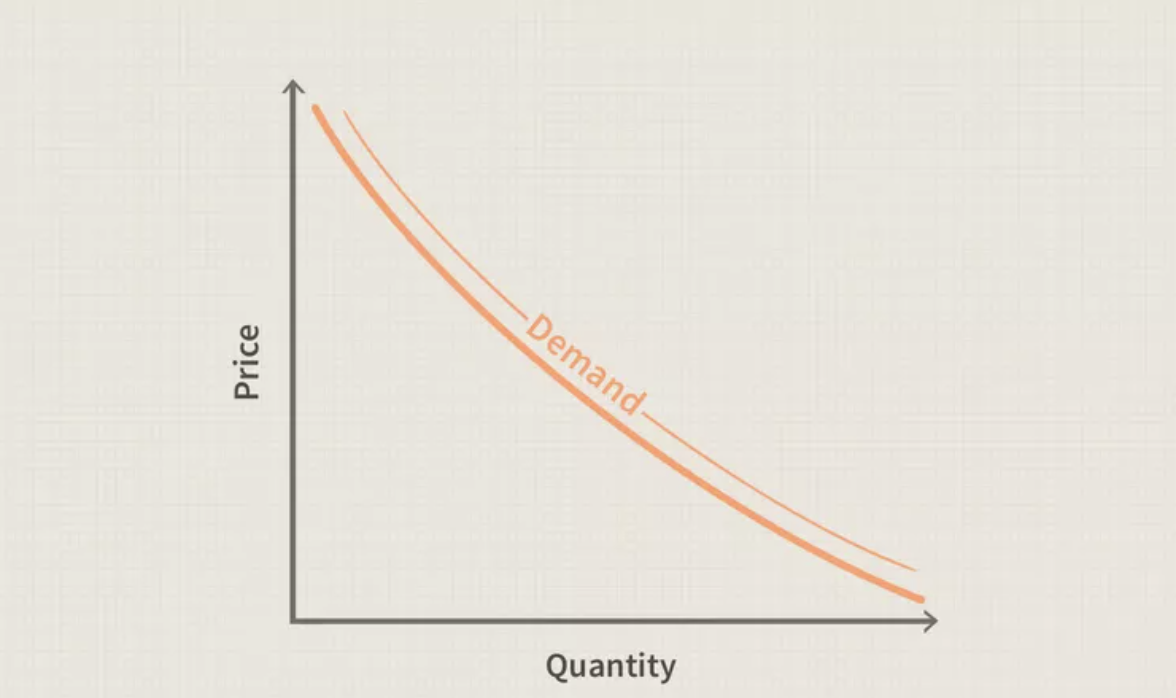
Ever wondered how economists and businesses make sense of consumer preferences and buying behaviours? One powerful tool they use is the market demand curve. Sounds a bit technical, but fear not – we’ll break it down in simple terms.
Imagine you’re at a market, and you’re checking out a product – let’s say, ASUS TUF Gaming A15 laptop. The market demand curve is like a magic graph that helps us understand the connection between the price of the laptop and how many people in the whole market would want to buy it. If it’s priced too low, the demand would be too high, and laptop manufacturers won’t make a profit. If it’s too high, there won’t be any sales. A good businessman would understand how to read this connection between price and demand optimally.
Think of a market demand curve like a graph that tells us how many people want to buy something at different prices. It shows the connection between price and how much stuff people are eager to get.
Related read: How to set the right price for your product or service
Factors affecting market demand
Market demand isn’t set in stone; it can fluctuate like the weather. Understanding what makes it rise or fall is crucial for business. Here comes the time to uncover the key factors that affect market demand with the following infographic.
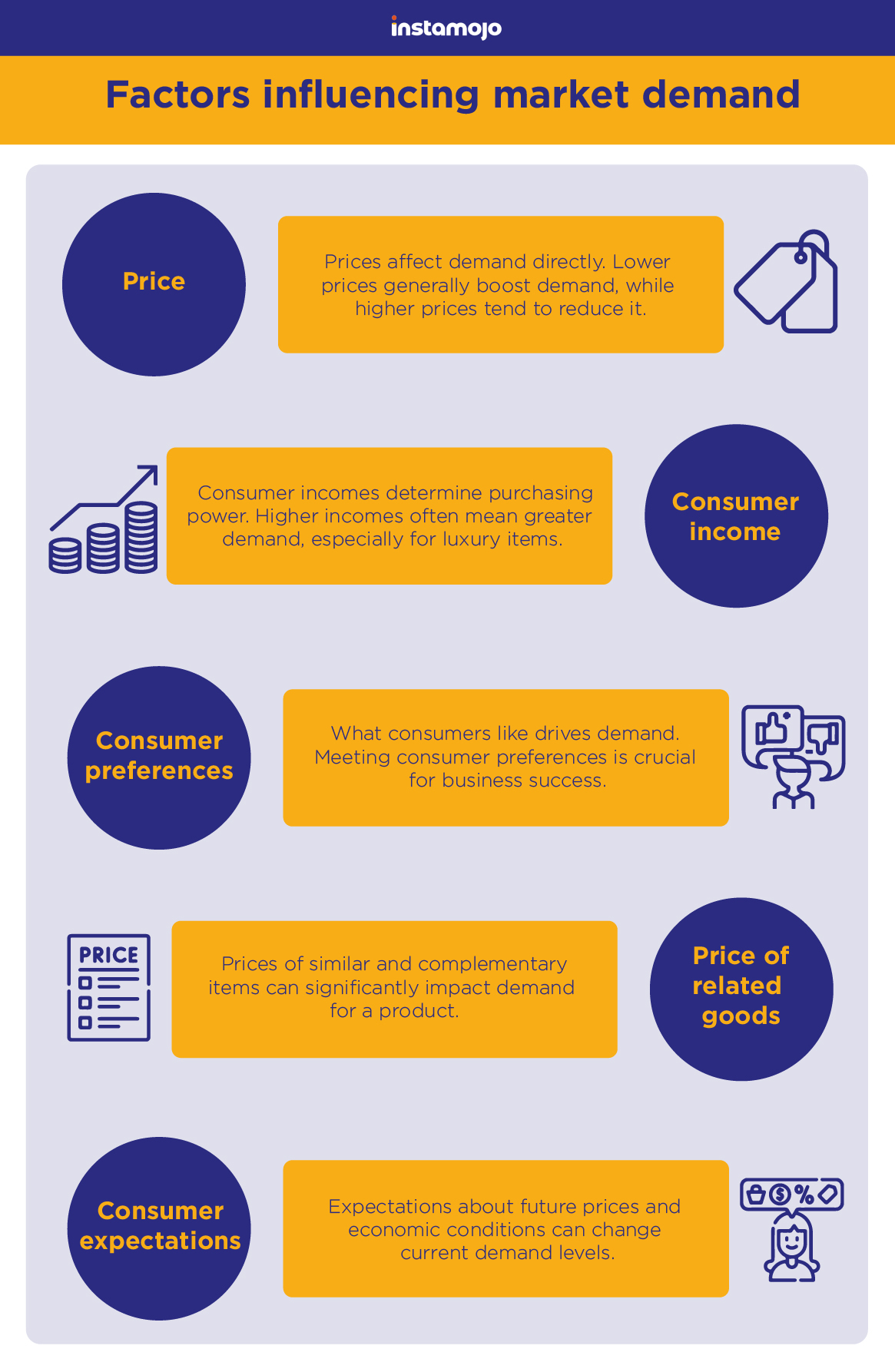
Importance of market demand analysis
Ever heard the saying, “Know your audience”? Well, in the business world, it’s more like, “Know your market demand.” Market demand analysis is a unique blend that can make or break a business. Let’s dive into why it’s so crucial:
1. Smart decisions
Market analysis guides businesses in making informed choices about what to produce, how much, and at what price. Think of a smartphone company that knows exactly what features people want.
2. Better products
Understanding customer desires leads to innovative products that resonate with the market, resulting in fewer misses and more hits.
3. Pricing sweet spot
Market analysis helps find the pricing sweet spot where customers are happy to pay, and the business can profit.
4. Targeted marketing
Businesses use demand analysis to focus their advertising efforts on specific customer groups, making campaigns more effective.
5. Demand forecasting
Predicting future demand with data and analysis helps businesses prepare for what customers will want tomorrow.
Related read: Demand forecasting in eCommerce: Definition, types and examples
Limitations and challenges of market demand
Market analysis is like a trusty tool in a business’s toolkit, but like any tool, it has its quirks and limitations. Let’s take a closer look at these challenges, as understanding them can help businesses fine-tune their strategies and make smarter decisions:
- Data accuracy matters: Bad data leads to bad decisions.
- Shifting preferences: Keep up with changing consumer tastes and trends.
- Watch external factors: Be ready for unexpected disruptions like economic shifts or disasters.
- Competitors count: Rivals’ moves can affect the demand.
- Data collection costs: It can be expensive and time-consuming to gather comprehensive data, especially for small businesses.
How to calculate market demand?
Calculating it is like solving a puzzle. It’s a process that helps businesses understand the total demand for a product or service in a given market. Here’s a step-by-step guide on how to calculate it:
- Define your market: Decide who you’re aiming to sell to – local, national, global? Be clear on your target.
- Gather data: Get the numbers you need on potential customers. Use census data, industry reports, or online research.
- Set the right price: Choose a price that makes sense based on costs, competition, and what customers are willing to pay.
- Understand individual demand: Figure out how much one person would buy at a given price. Ask people or check past sales data.
- Add it all up: Calculate the total market demand by adding everyone’s individual preferences.
- Watch for changes: Keep an eye on factors like income shifts, changing tastes, and the impact of your marketing.
- Predict future demand: Use past data and trends to make educated guesses about what’s coming.
- Stay adaptable: Market demand is always shifting. Keep gathering new info and adjust as needed.
Let’s understand these factors with a report released by Research and Markets:
The global health and wellness market hit US $3,481.8 Billion in 2022, driven by personalised life coaching, sedentary lifestyle-related chronic diseases, and workplace stress management. Likewise, it’s expected to reach US$ 4,454.0 Billion by 2028, with a 4.19% CAGR from 2022 to 2028.
Leveraging Instamojo to meet market demand: A practical approach
Instamojo is a versatile platform that simplifies the process of understanding and meeting market demand.
With easy setup, multiple payment options, in-depth analytics, customisation features, and customer engagement tools in your online store, Instamojo empowers your business to efficiently manage transactions, gather insights, and optimise offerings, ultimately helping them thrive in a competitive market by staying attuned to customer preferences and market trends.

